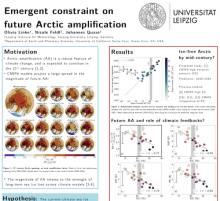An emergent constraint on future Arctic amplification and amplifying feedbacks
Olivia
Linke
Leipzig University
Poster
The rapid Arctic sea ice loss during past decades is a key driver of the amplified surface warming in the northern high latitudes, and simultaneously a major source of uncertainty in model projections of Arctic climate change. Previous studies have shown that the spread in model predictions of future Arctic amplification (AA) can be traced back to the inter-model spread in contemporaneous climatological sea ice loss.
Here we demonstrate that the strength of future AA is further linked to the current climate's, observable sea ice state across the multi-model ensemble of the 6th Coupled Model Intercomparison Project (CMIP6). The implication is that the sea-ice climatology sets the stage for the magnitude of climatological ice loss, which mediates the degree by which Arctic warming is amplified with respect to global warming.
In particular, we show that CMIP6 models with a lower sea ice in the current climate enable stronger ice melt in both future climate and during the seasonal cycle. Both processes systemically link to a larger future AA across climate models. These results are manifested by the role of climate feedbacks that have been widely identified as major drivers of AA: Models with low current-climate sea ice amount predict a stronger warming contribution through both sea-ice albedo feedback and temperature feedbacks in the future, as compared to models with high sea ice amount. From our derived linear regressions in conjunction with observations, we carry out an emergent constraint on the magnitude of future AA and the amplifying feedbacks, and find that AA is likely to continue through the 21st century under a high emission scenario, with the largest radiative feedback contribution from the SIAF.
Here we demonstrate that the strength of future AA is further linked to the current climate's, observable sea ice state across the multi-model ensemble of the 6th Coupled Model Intercomparison Project (CMIP6). The implication is that the sea-ice climatology sets the stage for the magnitude of climatological ice loss, which mediates the degree by which Arctic warming is amplified with respect to global warming.
In particular, we show that CMIP6 models with a lower sea ice in the current climate enable stronger ice melt in both future climate and during the seasonal cycle. Both processes systemically link to a larger future AA across climate models. These results are manifested by the role of climate feedbacks that have been widely identified as major drivers of AA: Models with low current-climate sea ice amount predict a stronger warming contribution through both sea-ice albedo feedback and temperature feedbacks in the future, as compared to models with high sea ice amount. From our derived linear regressions in conjunction with observations, we carry out an emergent constraint on the magnitude of future AA and the amplifying feedbacks, and find that AA is likely to continue through the 21st century under a high emission scenario, with the largest radiative feedback contribution from the SIAF.

linke-olivia-polar-poster.pdf
(1.95 MB)
